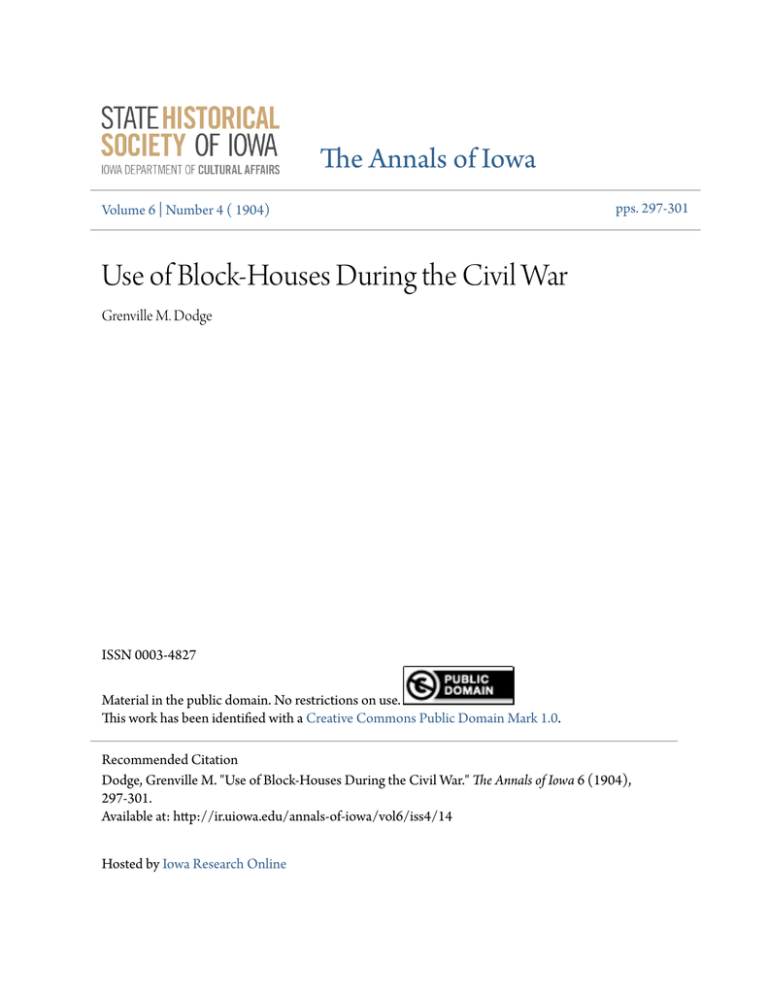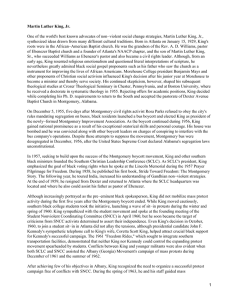Use of Block-Houses During the Civil War
Anuncio

The Annals of Iowa Volume 6 | Number 4 ( 1904) pps. 297-301 Use of Block-Houses During the Civil War Grenville M. Dodge ISSN 0003-4827 Material in the public domain. No restrictions on use. This work has been identified with a Creative Commons Public Domain Mark 1.0. Recommended Citation Dodge, Grenville M. "Use of Block-Houses During the Civil War." The Annals of Iowa 6 (1904), 297-301. Available at: http://ir.uiowa.edu/annals-of-iowa/vol6/iss4/14 Hosted by Iowa Research Online USE OF BLOCK-HOUSES DURING THE WAÏI. CIVIL BY MAJ. GEN. GEENVILLE M. DODGE. I was greatly interested in the communication of Captain Joubert Reitz, published in your journal March 21, 1903, giving a description of the block-house system inaugurated by General Kitchener in the Transvaal War. It was a continuous line of block-houses connected by barbed wire, to prevent the Boers crossing the railway lines, and virtually corralling their forces in certain districts until want of food forced them to surrender. Captain Reitz asserts that the block-house system did more to end the war than the whole British Army. In the Civil War our block-house system was just as effective, but in another direction. We used it for the purpose of protecting our lines of communication, not as a trocha, or a line connected with wire fencing and other obstructions, as used by the British and by the Spaniards in the Cuban War. The British built theirs of bags filled with earth. The Spaniards erected neat structures of two stories, built of concrete, with wooden roofs and openings for two lines of fire, one above the other. These were erected not more than half a mile apart. In the Civil War our blockhouses were usually erected of logs, one and two st;ories high. The face of the upper story had an angle of fortyfive degrees to the face of the first story, thus concentrating a direct fire upon an enemy approaching from any point of the compass. The first block-houses in the West that I know of were built by my command in July and August, 1862, when it rebuilt the Mobile and Ohio Railroad from Oolumbusto Humboldt. There were many important bridges on this line, and we built block-houses at the most important ones, and stockades at the others. In December, 1862, when Van Dorn, Forrest and Jackson 297 298 ANNALS OF IOWA. made the noted raid into West Tennessee, and defeated Grant's first Vicksburg campaign by the capture of Holly Springs, Mississippi, the forces at all these structures held their positions, and defeated the enemy when attacked, while at the bridges between Jackson, Tennessee, and Grand Junction, where they had only earth defences, the forces were driven away or captured. The result of this was that General Grant issued an order commending the action of the detachments that were successful, stating that wherever they stood success followed, and the enemy suffered a loss in killed and wounded greater than the garrisons of the block-houses and stockades. This result also caused General Grant to issue an order to build block-houses and stockades on the line of the Memphis and Charleston Railway at all important bridges from Memphis to Corinth, and they protected this line of communication until it was abandoned. The block, houses held about a company, but sometimes stockades or earth intrenchments were added to hold two companies, and our orders were imperative to all forces occupying them never to leave them or surrender, no matter how large the attacking force. My first order stated that a company in a block-house or stockade was equal to a regiment attacking, and I do not remember the enemy, in their numerous raids, ever capturing one that was defended, up to the time I left Corinth in the summer of 1863. After the battle of Chattanooga, when our armies were lying along the line of the railway from Nashville to Decatur and Nashville to Stevenson, I rebuilt the Nashville and Decatur Railway, on which there were at least thirty important bridges, at each of which we built strong block-houses and stockades, and the enemy never captured one of them, though in two instances they were attacked with a brigade, and often with two regiments and batteries. We protected against artillery fire by throwing up earthworks to the height of the first line of fire, taking the chance of any damage being done above that. Our orders here were when Forrest, Roddy and USE OF BLOCK-HOUSES DURING THE CIVIL WAR. 299 Hannan attacked this line to hold the posts under any and all circumstances, stating that if they stayed in the blockhouses and stockades nothing could defeat them, and so it proved. Where these forces struck a regiment, and captured it in earthworks, they went twelve miles north to th& Sulphur Trestle, a bridge one hundred and twenty-five feet high, defended by two companies in a block-house and stockade, and were signally defeated. The Army of the Cumberland protected the line from Nashville to Stevenson, and on to Chattanooga, with block-houses at all bridges and important points, and when on the 5th of May, 1864, General Sherman started on the Atlanta campaign. General Hooker reports on April 23, 1864, that he detailed 1,460 men to occupy block-houses from Nashville to Chattanooga, and this force held that line of road throughout the campaign, though many attempts were made to destroy it. During the Atlanta campaign as we advanced the railway was rebuilt, and all bridges and stations had block-houses or stockades to protect them. General Green B. Raum's brigade was located at some of the most important structures. General Wheeler, with all of Johnston's Cavalry force and several batteries, endeavored to destroy this, our only line of communication for transporting supplies. General Raum's story is so to the point that I quote it almost entire. He says: My experiences with block-houses extended from May to November,^ 186i, on the Memphis and Charleston Railroad, and the Chattanooga and Atlanta Railroad. Block-houses were bniit along these railroads exclusi vely for the protection of bridges. They were bnilt of heavy square timbers, sometimes with two or three thicknesses of timber, and were of various^ sizes. I had a two-story block-honse built at Mud Creek, east of Scottsboro, Ala.; it would easily hold 100 men. These houses were carefully pierced with loop holes, so that the garrison could cover every approach.^ My garrisons were usually too large for the block-houses. In these cases^ I threw np an earthwork, and protected it with abatis. The Confederate forces soon learned to respect a block-house. I found it to be an absolute defence against musketry. During the Atlanta campaign our block-houses were constantly attacked by raiding parties; small and great trains would be thrown from 300 ANNALS OF IOWA. the track and burned, and small sections of the track destroyed. About July 5, 1864, an enterprising Confederate cavalryman with about 300 men made a rapid march up Dirt Town Valley, crossed the Chattanooga range •by a bridle path, threw a train of 15 loaded cars off the track, burned them and destroyed a small section of the track, but he did not attempt to destroy the bridge near by at Tilton—it was defended by a block-house with a capacity for seventy men. When General Wheeler made his great raid north in August, 1864, he «truck the railroad at various places. He destroyed two miles of track immediately south of Tilton, Ga., but did not come within range of the block-house, and did not attempt to destroy the bridge defended by the block-house. During this raid General Wheeler, without hesitation, attacked and carried a part of the works at Dalton. During the Atlanta campaign there was not a bridge destroyed by the Confederates between Nashville and Atlanta which was protected by a block-house. After the fall of Atlanta, General Hood moved with his entire army against the Chattanooga and Atlanta Railroad, destroying 37 miles of irack. On October 12 he struck the railroad at Resaca and Tilton. Tilton was garrisoned by the 17th Iowa, Lieut. Colonel Archer commanding. He had about 350 men—no artillery. An army corps was in his front. Colonel Archer held the enemy off seven hours, fighting from his rifie-pits and block-house. At last the Confederate commander placed several batteries in position, and opened upon the devoted garrison. In a short time the block-house was rendered untenable, and Colonel Archer was forced to surrender. This was the first and only success against our block-house system. On Dec. 4, 1864, Bates' division of Cheatham's corps attacked the block-house at the railroad crossing of Overall's Creek, five miles north of Murfreesborough, Tenn. The enemy used artillery to reduce the block-house, and although 74 shots were fired at it, no material injury was done; the garrison held out until relieved by Gen. Milroy from Murfreesborough. After the Atlanta campaign, in the Department of Missouri, every important bridge and town where detachments of troops were stationed was protected by block-houses and stockades, and during the Indian campaigns of 1864-5, and 6, our lines of communication, stage and telegraph, were all held successfully by small detachments of troops in blockhouses and stockades and were never captured unless overwhelming forces of the Indians attacked them, and only then when the defensive works were inferior or not properly constructed, and even in cases where detachments left their stations if they had remained they would have successfully held them. After I took command on the plains and issued USE OF BLOCK-HOUSES DUEING THE CIVIL WAR. 301 positive orders for detachments to stay by their posts and never leave them, not a single detachment that I remember was captured in its block-house or stockade. With the small force we had it would have been impossible to maintain our mail, telegraph and overland routes successfully, if it had not been for our system of block-houses and stockades,^ dotted for thousands of miles over each of the overland routes. It is evident from our experience in the West that our block-house and stockade system of defending our linesof communication was a great success, not only as against raids of cavalry, but from attacks of infantry and artillery,, and saved to us a very large force for the field. I left on the line of the railway from Nashville to Athens during the Atlanta campaign only two regiments of negroes, taking with me my entire corps, and without the block-houses todefend the lines from Nashville to Stevenson and Stevenson to Atlanta, it would have taken a thousand men without block-house protection for every hundred required with it. From ihe Army and Navy Journal. HISTORICAL COLLECTIONS may consist of a wide range of objects, representing not only America, but the nations with which the Ü. S. have relations, and particular interest attaches to such things as have been associated with prominent national personages or with great nationarevents ; these areof lasting interest. Among specimens may be mentioned weapons and munitions of all kinds—cannon, rifles, pistols, projectiles, torpedoes, swords, knives, etc.; all kinds of minor devices and appliances employed in navigation, land transportation, signaling, engineering, etc.; banners, uniforms, costumes, and separate parts of costumes; medals, coins, badges, books, documents, maps, and photographs, in fact anything that may serve as a representative of historical personages or events.—Sniithsonian Institution Instructions to Collectors.


